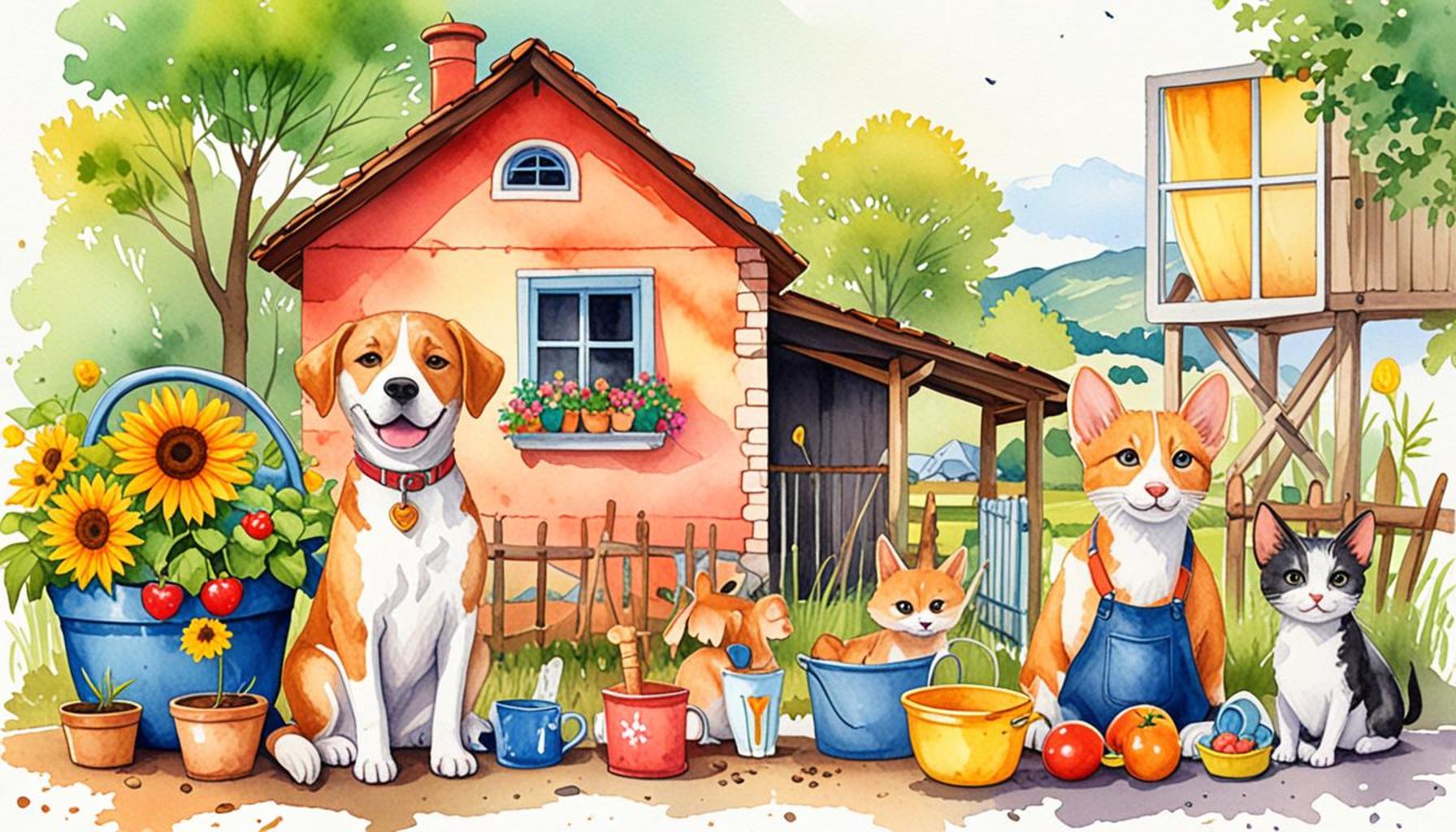Practical Guide to Pet Care in Rural Areas Essential Tips Advice

Understanding Pet Care in Rural Settings
Caring for pets in rural areas presents unique challenges and rewards. With more open space and closer ties to nature, pets can thrive in ways that urban counterparts may not. However, rural pet ownership also demands attention to specific needs and circumstances.
Key Considerations for Rural Pet Owners
Whether you’re a seasoned rural pet owner or new to the lifestyle, it’s essential to stay well-informed. Here are some important aspects to consider:
- Access to Veterinarians: One of the most significant challenges faced by rural pet owners is limited access to veterinary care. Rural areas may have fewer veterinary clinics, and those that exist can be located far from home. It’s advisable to understand the location and availability of veterinary services, especially emergency care. Many rural pet owners establish relationships with local vets who can provide home visits, and some even use telehealth services for consultations.
- Environment Adaptation: Rural pets often experience diverse weather patterns and varied terrains that urban pets do not. For instance, larger outdoor spaces might expose pets to harsh weather conditions, from scorching summer heat to freezing winters. Pet owners should ensure that animals are provided with adequate shelter, protection from the elements, and a suitable diet tailored to seasonal changes. Additionally, implementing preventative measures against common rural hazards such as ticks and fleas can enhance your pet’s health.
- Wildlife Interaction: Living in rural settings increases the likelihood of encounters with local wildlife, including deer, raccoons, and even predators like coyotes. Pets, especially dogs, may find themselves intrigued by these animals, leading to dangerous situations. It is vital to supervise pets during outdoor activities and train them to respond to commands promptly. Keeping your pet on a leash or within a secured area is a prudent measure to prevent unforeseen wildlife encounters.
As pet owners, you have a responsibility to ensure a safe and enriching environment for your furry companions. This guide will explore practical tips and expert advice tailored to the rural lifestyle, emphasizing how to navigate the distinctive aspects of pet care in these areas. For instance, considering the nutritional needs of pets is crucial; rural areas may require pet owners to source high-quality food that meets specific dietary requirements, possibly even from local farms or co-ops.
Furthermore, socialization is a key factor in pet well-being, and rural owners should seek out opportunities to engage their pets with others. This might include local dog parks, training classes, or community pet events. By fostering social interactions, you help your pet develop confidence and reduce any behavioral issues that may arise from isolation.

Overall, equipping yourself with knowledge about proper nutrition, health monitoring, and socialization will significantly enhance your pet’s quality of life in a rural setting. The joys of rural pet ownership are manifold, offering a deeper connection to nature, yet it requires a proactive approach to ensure the health and happiness of your beloved companions.
SEE ALSO: Click here to read another article
Navigating the Reality of Rural Pet Ownership
Understanding the dynamics of pet care in rural settings goes beyond merely welcoming a pet into your home. It requires awareness of their unique needs and the environment in which they will live. Here are some essential tips and advice aimed at enhancing the experience of pet ownership in the countryside.
Nutrition and Diet Tailoring
In rural areas, access to commercial pet food brands may be limited, making it crucial for pet owners to find alternatives that can provide a balanced diet. Consider partnering with local farms or co-ops that offer high-quality, organic pet food options. Additionally, rural pet owners are in an ideal position to explore homemade pet food. By sourcing fresh ingredients directly from local farms, you can tailor your pet’s diet to their specific health needs, promote better digestion, and even possibly save on overall costs.
When managing your pet’s diet, keep the following tips in mind:
- Consult Your Veterinarian: Always start with a discussion about your pet’s dietary requirements. A veterinarian can provide guidelines for proper nutrition based on age, size, and specific health concerns.
- Monitor Weight: Keeping an eye on your pet’s weight helps to prevent obesity, a common issue among pets in rural areas with less activity due to seasonal changes.
- Local Ingredients: Utilize seasonal fruits and vegetables to enhance pet meals. Items like pumpkin, peas, and carrots can offer essential vitamins while providing a tasty supplement to their diet.
Health Monitoring and Preventive Care
Maintaining your pet’s health in a rural environment requires vigilant monitoring and proactive measures. Regular health checks are essential, especially since rural pets may be exposed to different parasites and health hazards compared to their urban counterparts. Here are some preventive practices to keep your pet in top condition:
- Vaccinations: Ensure that your pets are up-to-date on vaccines, especially those protecting against Lyme disease and rabies, which can be more prevalent in rural regions due to wildlife interactions.
- Parasite Prevention: Regular treatments for fleas, ticks, and worms are crucial, as pets in rural settings often have higher exposure levels. Consult with your vet for the best preventative measures.
- Regular Check-ups: Schedule routine visits to the vet—even in the absence of immediate health issues. These check-ups help identify any potential problems early.
By prioritizing nutrition and health monitoring, rural pet owners can create a nurturing environment that fosters both physical health and emotional well-being for their pets. Understanding these foundational elements will allow you to enjoy the freedom of rural pet ownership while safeguarding your pets’ quality of life.
| Category | Details |
|---|---|
| Local Resources | Utilizing nearby farms, feed stores, and veterinary clinics ensures you have access to quality supplies and care. |
| Outdoor Environments | Access to open spaces allows pets to exercise freely, fostering their physical and mental well-being. |
The rural landscape offers unique benefits and challenges for pet owners. A key advantage is the availability of local resources. Rural areas often host a variety of farms and feed suppliers that provide accessible, high-quality supplies tailored for local pet needs. Engaging with local veterinarians who are familiar with the common health issues faced by pets in rural settings can also be invaluable.Additionally, the outdoor environments available in rural areas create opportunities for pets to thrive. Open fields, forests, and nature trails provide ample space for exercise, reducing anxiety and promoting joyful exploration. Understanding the potential hazards of the rural outdoor experience, such as encounters with wildlife or exposure to parasites, is essential for effective pet care. By combining these local resources with the vast outdoor experiences, pet owners can ensure a holistic approach to caring for their animals in a rural environment.
SEE ALSO: Click here to read another article
Enriching Pet Life Through Engagement and Exploration
In the expansive landscapes of rural areas, pets have unique opportunities for exploration and engagement that can greatly enhance their quality of life. However, this freedom comes with additional responsibilities for pet owners to ensure their safety and well-being. Here are key measures to enrich your pet’s life in rural settings while keeping them safe and healthy.
Exercise and Mental Stimulation
Rural living often translates to vast open spaces, which can be a playground for pets. Yet, this freedom necessitates purposeful planning to ensure your pets receive the right amount of exercise and mental stimulation to thrive.
- Structured Playtime: While your pet may enjoy roaming, structured play sessions are vital. Set specific times for running, fetching, or agility training. This structure not only maintains their physical health but also strengthens the bond between you and your pet.
- Variety of Activities: Incorporate different activities that challenge your pet’s mind. Hide and seek games, scent trails, or toy puzzles stimulate their mind and curb boredom—a significant factor in undesirable behaviors.
- Socialization Opportunities: Encourage your pets to interact with other animals in your community safely. Attend local dog parks or go on group walks to nurture their social skills and provide necessary exposure to different environments.
Safety Measures for Rural Adventures
While the allure of the great outdoors is undeniable for pets, it is essential to implement safety measures to protect them from potential hazards that can arise in rural settings.
- Identification and Microchipping: Ensure your pets have proper identification tags and consider microchipping. In vast open areas, pets can easily wander off; having proper identification increases the likelihood of a safe return.
- Leash Training: Train pets to walk on a leash and consider using a harness for added security during outdoor excursions. This not only helps with control but can protect them from sudden encounters with wildlife.
- Hazard Awareness: Be vigilant about environmental risks, including poisonous plants, wildlife encounters, and potential dangers such as vehicles on less populated roads. Familiarize yourself with the local flora and fauna to keep your pets safe from any threats.
Grooming and Seasonal Care
Grooming needs can vary significantly based on climate and terrain present in rural areas. Regular attention to grooming is not just about aesthetics; it is crucial for your pet’s overall health and comfort, especially given the diverse conditions of country life.
- Regular Grooming Routines: Long-haired pets may require more frequent grooming to prevent mats and tangles, especially in drier seasons where dust and debris abound. Invest in a quality brush and establish a grooming schedule to maintain your pet’s coat health.
- Seasonal Care: Understand how seasonal changes affect your pets. For instance, during winter months, consider protective gear to safeguard their paws from salt and ice. In summer, be cautious of heat exhaustion and ensure they always have access to fresh water and shaded areas when outdoors.
- Skin Health: Regularly check your pet’s skin for signs of irritation or parasite infestation that can be more prevalent in rural areas. Invest in appropriate flea and tick prevention methods as these pests thrive in natural environments.
By prioritizing engagement, safety, and grooming, rural pet owners can provide their pets with fulfilling lives enriched by exploration while maintaining their health and safety. These considerations not only enhance your pet’s life but also weave a stronger connection to the rural lifestyle and its enriching experiences.
CHECK OUT: Click here to explore more
Conclusion
In summary, practical pet care in rural areas requires a balanced approach that prioritizes the well-being of our furry companions while embracing the benefits of country living. Engaging pets through structured activities and mental stimulation not only fulfills their natural instincts but also fosters the human-animal bond essential for a happy life together. Furthermore, understanding how to keep pets safe from environmental hazards and ensuring they are properly groomed can protect their health and enhance overall quality of life.
By proactively addressing these key aspects—such as implementing appropriate safety measures, promoting regular grooming routines, and maintaining seasonal care—pet owners can create a harmonious living environment that thrives on exploration and engagement. It’s important to remember that each pet is unique; therefore, customization based on individual needs, preferences, and the specific rural landscape is crucial.
As you navigate rural pet ownership, keep in mind that the commitment to your pet’s care extends beyond basic needs. Stay informed about local wildlife interactions, emerging health trends, and community resources that can further enrich your experience together. Engaging with fellow pet owners in your rural community can also provide valuable insights and support as you embark on this rewarding journey. Embrace the challenges and joys of rural pet care, and you will undoubtedly create lasting memories with your beloved animal companions.



